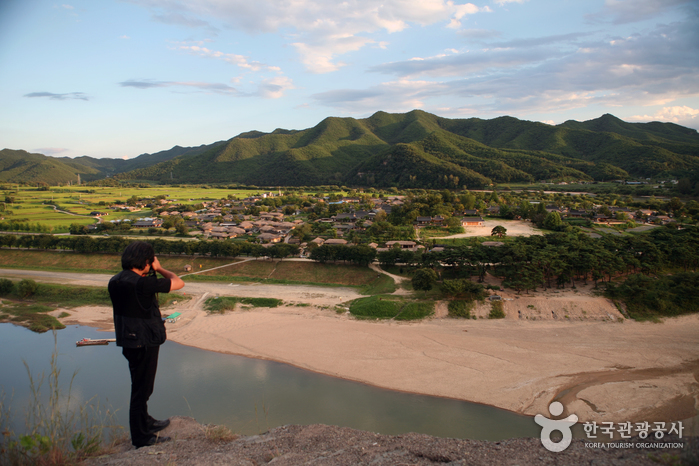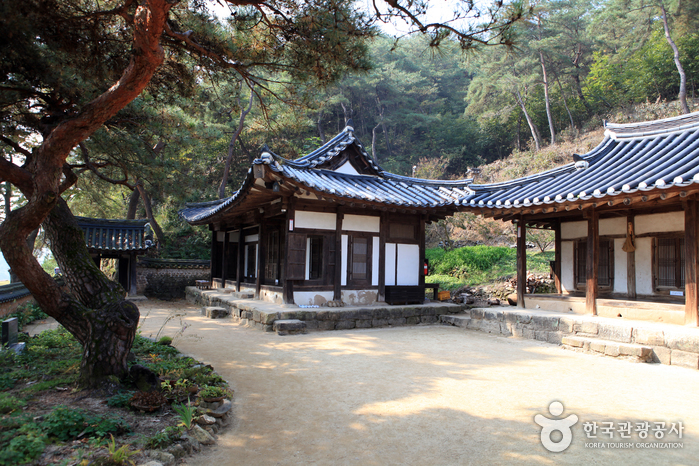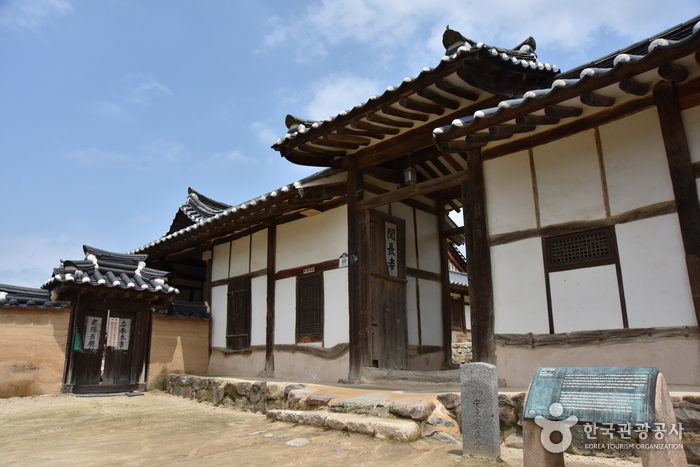Falaise de Buyongdae (부용대)
17.6Km 2021-05-25
72, Gwangdeoksolbat-gil, Pungcheon-myeon, Andong-si, Gyeongsangbuk-do
+82-54-852-6800
La falaise de Buyongdae mesure 64 mètres de haut et se situe à l’extrêmité de la chaîne de montagnes Taebaek. Le sommet offre une vue panoramique du village de Hahoe à Andong. Son nom vient d’une ancienne histoire chinoise. Le nom de Buyongdae, qui signifie lotus, lui aurait été donné à cause de la configuration du village de Hahoe en forme de fleur de lotus. Par conséquant, c’est depuis la falaise que l’on a la meilleure vue de Hahoe. A proximité de Buyongdae se trouve la maisone de Ogyeonjeongsa, la maison de Gyeomamjeongsa et l’académie de Hwacheon Seowon.
Maison Ogyeonjeongsa (하회옥연정사)
17.7Km 2017-05-24
86, Gwangdeoksolbat-gil, Pungcheon-myeon, Andong-si, Gyeongsangbuk-do
La Maison Ogyeonjeongsa, située au pied de la falaise Buyongdae dans le village de Hahoe à Andong, a été construite par Ryu Seong-yong, qui fut ministre durant la période Joseon. Sa construction a débuté en 1576 (9ème année du règne du roi Seonjo) et s’est achevée en 1586 (19ème année du règne du roi Seonjo). C’est dans cette maison que furent écrites les mémoires de guerre « Jingbirok » après l’Imjinwaeran, l’invasion de la Corée par le Japon en 1592. Pour vous rendre à la maison Ogyeonjeongsa, il vous faut traverser la rivière en ferry. En dépit de l’apparence modeste de la demeure, la beauté sans prétention de cette maison coréenne se fond parfaitement dans le magnifique cadre naturel des falaises, de la rivière et de la forêt.
* Ecole Sesimjae
Cette école privée est dotée en son centre d’un plancher en bois Gamrokheon, flanqué de chambres de chaque côté.
* Maison Wolnakjae
Wolnakjae signfie « attendre un ami ». C’est dans cette maison que le ministre Ryu Seong-yong a écrit ses mémoires de guerre Jingbirok.
* Centre d’activités
Sesimjae (deux chambres de quatre personnes maximum chacune, plancher en bois Gamrokheon)
Wolnakjae (une chambre pour huit personnes maximum, plancher en bois Aeoheon)
Okyeon pavilion [Korea Quality] / 옥연정사 [한국관광 품질인증]
17.7Km 2023-04-13
86, Gwangdeoksolbat-gil Pungcheon-myeon, Andong-si, Gyeongsangbuk-do
+82-54-854-2202 / +82-10-4520-3640
Ogyeonjeongsa House was established by Ryu Seong-yong (pen-name: Seoae, 1542-1607), a minister of Joseon, with the help of Buddhist monk Tanhong, as a place to study and educate his students. After building Wonjijeongsa House, Ryu wanted to build another house at the foot of Buyongdae Cliff amid a tranquil environment away from the village, but due to his financial situation he was unable to complete the building by himself. Then, the monk Tanhong helped him build Ogyeonjeongsa House, which took ten years (1576 to 1586) to complete, when Ryu was 45 years old. Later, Ryu Seong-yong was able to share warmth with his brother (Gyeomam), who lived in nearby Gyeomamjeongsa House. Ryu later lost his house in Hahoe in the great flood of the Nakdonggang River in 1605, and retired to Ogyeongjeongsa House where he wrote Jingbirok (The Book of Correction, National Treasure 132), a memoir of the Imjin War (Japanese Invasion of Korea in 1592). The house’s guestrooms include Sesimjae (meaning ‘having a mind to this place to achieve at least one in ten thousand things,’ inspired by the I Ching or The Book of Changes), which was used by Ryu as a schoolhouse and has two small rooms between the maru gamheonrok (wooden floor, meaning ‘looking up at the sky and down at the blue water,’ inspired by Wang Xizhi’s poetic diction); Wonlakjae (meaning ‘waiting for a friend’s visit,’ inspired by the Analects of Confucius), in which Ryu himself resided and wrote Jingbirok; and the maru aeoheon (meaning ‘I also love my hut,’ taken from a poem by Chinese poet Tao Yuanming), which measures two kan (a unit of measurement referring to the distance between two columns).
RakKoJae Andong(Hahoe) [Korea Quality] / 락고재 안동(하회) [한국관광 품질인증]
18.0Km 2023-04-13
51, Hahoegangbyeon-gil, Pungcheon-myeon, Andong-si, Gyeongsangbuk-do
+82-54-857-3410
Rakkojae, meaning “a place where one can enjoy ancient traditions and rest one’s soul”, is located near the beautiful ferry on the Nakdonggang River in Hahoe, Andong. After passing by a pine tree decorated with traditional Korean lanterns and entering the cozy courtyard, visitors will find four well-maintained houses with thatched-roofs made with local rice straw. As Rakkojae is some way from the Hahoe Village, and is adjacent to the Nakdonggang River, guests can enjoy walking along the ferry and the walkway while appreciating the beautiful scenery of the river and Buyongdae Cliff with its serene atmosphere. Rakkojae has three guest accommodations – the anchae at the front, the sarangchae and the byeolchae on the sides, and the munganchae. While the anchae has two rooms, a kitchen and a daecheong (main floored room), both the sarangchae and the byeolchae consist of a daecheong and one room. The maximum number of guests per room is ten so that guests can enjoy their stay with ease. Each room is decorated with hanji (traditional Korean paper handmade from mulberry trees) and features a simple built-in closet, ceiling-type air conditioning, and a modern bathroom with a toilet and a bathtub made of Hinoki cypress. In particular, the munganchae has a red clay jjimjilbang (Korean dry sauna) supplied with mugwort that is popular among both domestic and foreign guests. Guests often enjoy relaxing at Rakkojae by appreciating the sunshine and breeze while lying on the daecheong floor, walking barefoot on the earthen ground, and drinking makgeolli (unrefined rice wine)among other activities. The owners of Rakkojae hope that it will be a place where guests can heal their tired body and mind and experience the true atmosphere of Korea. The Pine Wood of Mansongjeong Pavilion (Natural Monument No. 473) situated next to Rakkojae is also a good place for a stroll. Furthermore, the hotel serves a hearty breakfast consisting of heotjesatbap (Andong-style bibimbap with soy sauce) and salted grilled mackerel.
Bukchondeak [Korea Quality] / 하회 북촌댁 [한국관광 품질인증]
18.0Km 2020-09-08
7, Hahoebukchon-gil, Pungcheon-myeon, Andong-si, Gyeongsangbuk-do
+82-54-853-2110, +82-10-2228-1786
Located in Hahoe-ri (Pungcheon-myeon, Andong-si, Gyeongsangbuk-do), Hahoe Bukchondaek House is a hanok stay that was originally built by a civil official named Ryu Sa-chun in 1797 (the 21st year of the reign of King Jeongjo of the Joseon dynasty). It consists of a small sarangchae (men’s quarters) with two wing buildings at sides. As the anchae (women’s quarters), large sarang, daemungan (gate building), and shrine were built by Ryu’s great-grandson, Ryu Do-seong (who served as a governor of Gyeongsang-do), in 1862 (the 13th year of the reign of King Cheoljong), the house displays the typical features of a Joseon nobleman’s house and is the largest in Hahoe. The large sarangbang, Bukchonyugeo (measuring 7-kan* at the front, 3-kan at the sides), consists of two 2-kan rooms, two 1-kan rooms, a 4-kan daecheong (wooden floor), a 3-kan numaru (upper floor), a 3-kan kitchen, a 3-kan garret, a 5-kan toe (the narrow wooden veranda running along the outside of the building), and a jjokmaru (narrow wooden veranda). The entire building can be converted into a single space simply by opening the sliding doors between the rooms and the doors between the rooms and the daecheong. The medium-sized sarang, Hwagyeongdang, consists of a 2-kan room, a 1-kan daecheong, a 3-kan toe, and a jjokmaru, while the small sarang, Susinwa, consists of a 1-kan room, a 1-kan daecheong, and a 2-kan toe. The anchae has a courtyard in the middle, a kitchen, a main room, a daecheong, a gobang (storeroom), a witsangbang (upper room), a toenmaru (a narrow wooden porch running along the outside of the building), an araetsangbang, a jungmun that links to the large sarang, an araetgwang (storeroom), a dwiju (grain-chest), and a munganbang (gate building room). The munganchae (gate building) and shrine are also situated within the grounds of the house, along with a 300-year-old pine tree that is known for its curved shape, which is said to resemble the Nakdonggang River as it meanders around the village of Hahoe. The house contains valuable cultural heritages including Doseongpaldojido (Map of the Eight Provinces of Korea), which is estimated to date from the seventeenth century, and is regarded as an invaluable historic material as it includes Dokdo Island and Jiandao as part of the Korean territory, and a painting titled ‘Sehwa,’ which is believed to have been given to Ryu Yi-jwa (pen-name: Hakseo, 1763-1837) by the king as a New Year’s present. Bukchondaek House was built by one of the richest families in Hahoe, who are well known for their generosity as they have helped local people on many occasions throughout history. *kan: a unit of measurement referring to the distance between two columns.
Yangjindang / 하회 양진당
18.0Km 2025-03-05
68, Hahoejongga-gil, Andong-si, Gyeongsangbuk-do
+82-10-4113-8760
“Andonog Hahoe Yangjindang,” located in the Hahoe Folk Village, is Treasure No 306 and the residence of a family with the surname Pungsan Ryu. A tablet read Ipam Antique House, named after Ipam Ryu Jung Yeong (1515 - 1573), is hung on the entrance. Yangjindang is named after the nickname of Ryu Yeong (1687 - 1761), the sixth generation of Gyeongam Ryu Un Ryong, son of Ipam. The name means “nourishing well one's own nature.” The Hanok stands over the entrance, with a well-polished floor that is grand yet friendly. One of the characteristics of the house is that it includes Sarangcha or detached building, which reflects the architecture from the Goryeo period, and Anchae or main building in the architecture style from the Joseon period.
It is expected that such co-existence was made possible because of the repairs done after Imjin War. How fortiunate that the antique house has been preserved until now! The well-tended garden shows the commitment of the descendants to maintaining the space. Rooms are rather simple compared to the grand exterior of the house. Traditional mother-of-pearl furniture, tableware in the cupboard, randomly ceramics placed draw attention. The house resembles a small folk museum. Why not enjoy some traditional folk games during your stay? There is a variety of play tools such as yut, tuho, jegi, tops, and kites. Experience programs such as gayangju brewing, rice cake and traditional dessert making, and flower tea are conducted by the first daughter-in-law of the house, depending on the season.
Village Hahoe à Andong [Patrimoine Mondial de l'UNESCO] (안동 하회마을)
18.1Km 2024-10-25
Gyeongsangbuk-do, Andong-si, Pungcheon-myeon, Hahoe-ri 1176-1
+82-54-853-0103
Le village Hahoe désigne historiquement le foyer des descendants du clan Ryu de Pungsan, le site est célèbre pour ses maisons traditionnelles. Lieu de naissance d’illustres lettrés de la période Joseon tels que Ryu Un-Ryong et Seoae Ryu Seong-Ryong, le village devint encore plus célèbre apres que la Reine Elizabeth II l’ait visité le 21 avril 1999.
Le village Hahoe (que l’on peut traduire par « Village Enveloppé d’Eau ») tire son nom du fleuve Nakdong, qui passe autour de son périmètre. Il est situé au contrefort de la montagne Hwasan, adjacente à la montagne Taebaek qui s’élève à l’est. Le centre du village est peuplé de larges maisons aux toitures en tuiles appartenant au clan Ryu, ajoutant leur charme unique aux toits de chaumes environnants.
Le village se distingue également par see charmantes vues pittoresques : l’élégant fleuve Nakdong passant autour du village, la magnifique falaise Buyongdae, des plages de sable ainsi que des pins anciens luxuriants. Les visiteurs peuvent prendre le bateau pour la falaise afin d'apprécier une vue panoramique du village.
En plus de paysages, le village propose des mets locaux raffinés. Il est possible notamment de déguster le Soju d’Andong, le Heotjesabap (type de bibimbap mangé par les nobles), le Gangodeungeo d’Andong (maquereau salé) ou encore le Guksu d’Andong (genre de plat à base de nouilles).
Les attractions à proximité incleunt les structures suivantes : le temple Bongjeongsa (érigé pendant la période Silla), la montagne Waryongsan, Gosan Seowon (une académie confucéenne), Gwiraejeong ainsi que les forêts de loisirs des montagnes Gyemyeongsan et Hakgasan.
Tout comme le village Yangdong à Gyeongju, le village Hahoe fut ajouté à la liste du Patrimoine Mondial de l’Humanité de l’UNESCO dans la catégorie « Villages Historiques de Corée » le 31 juillet 2010.
Ga Gyeong Jae [Korea Quality] / 가경재 [한국관광 품질인증]
18.1Km 2023-04-13
69-5, Hahoenamchon-gil, Andong-si, Gyeongsangbuk-do
+82-54-855-8552
Gagyeongjae, or House with a Beautiful View, is a place with a thatched roof and an unhindered view. Guests can enjoy the view of natural environment over the window, with cool breeze freely flowing in the rooms. There are five rooms in total including Anchae Sangbang, Sarangchae Upper Room and Lower Room, Ondol Red Clay Lower Room, and Door Room. Guests in Anchae can use the central porch, whereas guests in Sarangchae can take advantage of the central floor as well. Ondol Red Clay Room is popular; it is heated by the owner himself through the traditional fireplace outside the room. The room, however, requires reservation at least 2 days in advance.
Air conditioners were recently installed in the hanok. Additional fees are separately charged in summer, but it is just great to enjoy air conditioning in a hanok. Note that reservation and inquiry over the phone is faster and more convenient than that on the website. There are many restaurants and places to experience in Hahoe Folk Village. It is a nice place to enjoy many things and just relax.
Ecole confucianiste Dosanseowon [Patrimoine Mondial de l'UNESCO] (도산서원)
18.1Km 2023-05-23
154, Dosanseowon-gil, Andong-si, Gyeongsangbuk-do
+82-54-852-6800
L’école confucéenne Dosanseowon a été établie en 1574 (7ème année du règne du roi Seonjo), par des disciples des mémoires du premier Lee Hwang.
La salle de conférence Dosan désigne une ancienne académie où Lee Hwang enseignait les études académiques. En 1574 (la 7ème année du règne du roi Seonjo (1567~1608) de la dynastie Joseon (1392~1910)), des érudits confucéens et d’autres lettrés ont inauguré un lieu saint appelé Sangdeoksa. En 1969, il a été désigné comme trésor national Nº 170. Après avoir placé l'espace funéraire et offert les rites sacrificiels, la salle de conférence a été terminé avec la construction de Jeongyodang (Trésor National Nº 210) ainsi que les ailes ouest / est (lieu d'étude pour les savants).
Lorsque vous entrez par l’entrée principale, vous trouverez la salle de conférence Dosan sur votre droite. La structure du bâtiment est simple avec des pilliers carrés et des poutrelles insérées dans les traverses. Si vous continuez plus loin derrière la salle de conférence en passant par la porte Jindomun, vous trouverez la salle Gwangmyeongsil où sont gardés des livres anciens. Vous trouverez également le bâtiment principal Jeongyodang et les ailes ouest / est.
Derrière Jeongyodang, on trouve le lieu saint Sangdeoksa, Jangpangak ainsi qu’un arbre où sont imprimés les ‘12 Chants de Dosan’. Le pavillon Okjingak, qui a été reconstruit en 1970, est désormais un bâtiment d’exposition des reliques de Toegye.
Garam Choyeonjae [Korea Quality] / 가람초연재 [한국관광 품질인증]
18.1Km 2020-09-09
76-6, Hahoejongga-gil, Pungcheon-myeon, Andong-si, Gyeongsangbuk-do
+82-10-3849-7542
Garam Choyeonjae offers guests a variety of charming features, particularly the harmonious natural environment which creates a serene and relaxing atmosphere. Situated in Hahoe, which is partially enclosed by the Nakdonggang River, Garam Choyeonjae stands out among the village’s many hanok houses due to its beautiful thatched roof. The village has become a popular tourist destination thanks to the distinguished natural landscape along the Nakdonggang River, its 100 ~ 200-year-old hanok houses, and nearby Buyongdae Cliff, which commands a panoramic view of the village. The name of the house is a compound word consisting of ‘garam’, which is the pen-name of the house’s owner, a 15th–generation descendant of Ryu Seong-ryong (pen-name: Seoae, 1542-1607, a scholar-official of the Joseon Dynasty), and ‘choyeonjae’, which means “a thatched house in which swallows live.” Guests can even see the swallows and their nests under the rafters and eaves of this simple, cozy hanok. The house is also surrounded by various well-known buildings such as Damyeonjae House, the largest and oldest hanok in the village; Yangjindang House (Treasure No. 306); and Binyeonjeongsa House (National Folklore Cultural Heritage No. 86), which was built and used as a library by Ryu Un-yong (pen-name: Gyeomam). Garam Choyeonjae consists of two rectangular hanok buildings with clean and well-maintained rooms exuding a traditional and antique atmosphere. In particular, the house’s beautifully maintained thatched roof attracts many foreign visitors. The house also provides various experience programs, including an opportunity to use a treadmill, millstone, and mortar, and a gat-making experience (a gat is a Korean traditional hat made of bamboo and horsehair). Moreover, visitors are highly recommended to appreciate the fantastic view of the sunset from the wooden floor of the house’s sarangchae (men’s quarters), and the beautiful garden planted with seasonal wildflowers.


![Okyeon pavilion [Korea Quality] / 옥연정사 [한국관광 품질인증]](http://tong.visitkorea.or.kr/cms/resource/50/2578050_image2_1.jpg)
![RakKoJae Andong(Hahoe) [Korea Quality] / 락고재 안동(하회) [한국관광 품질인증]](http://tong.visitkorea.or.kr/cms/resource/84/2573784_image2_1.jpg)
![Bukchondeak [Korea Quality] / 하회 북촌댁 [한국관광 품질인증]](http://tong.visitkorea.or.kr/cms/resource/74/2626274_image2_1.jpg)


![Ga Gyeong Jae [Korea Quality] / 가경재 [한국관광 품질인증]](http://tong.visitkorea.or.kr/cms/resource/00/2626200_image2_1.jpg)
![Garam Choyeonjae [Korea Quality] / 가람초연재 [한국관광 품질인증]](http://tong.visitkorea.or.kr/cms/resource/43/2579443_image2_1.jpg)
 Français
Français
 한국어
한국어 English
English 日本語
日本語 中文(简体)
中文(简体) Deutsch
Deutsch Español
Español Русский
Русский